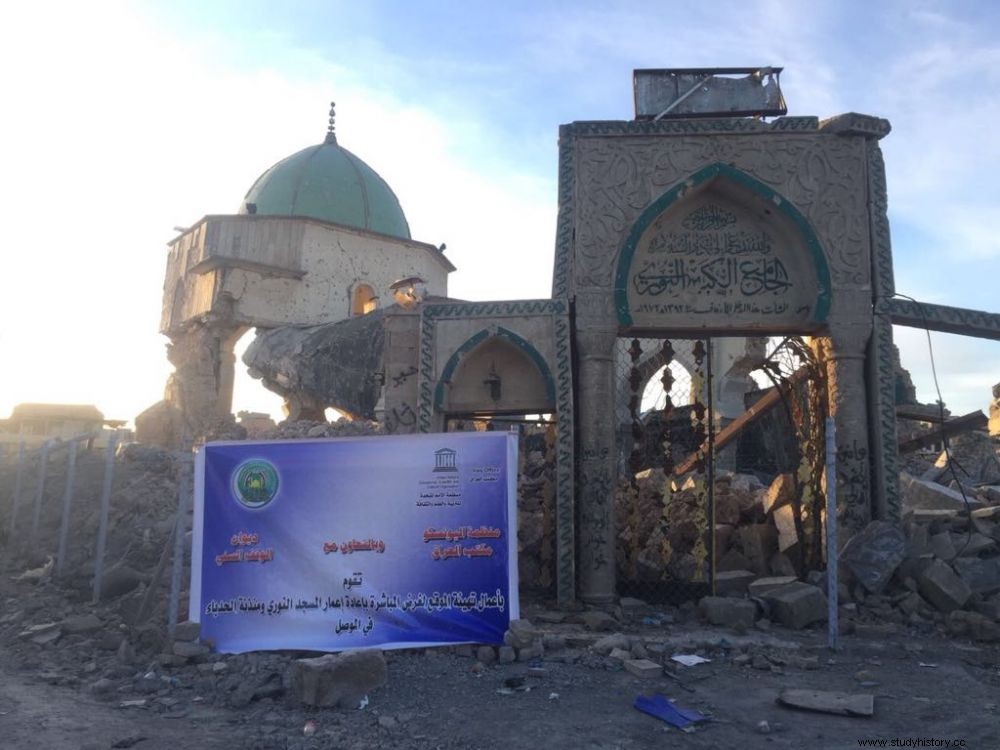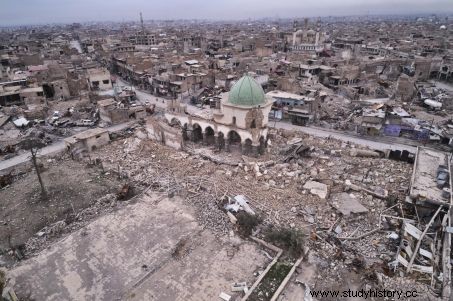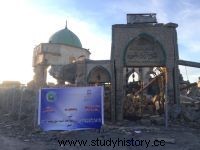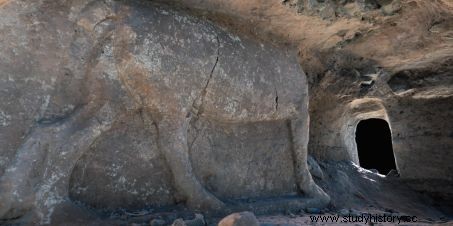On September 10, 2018, the first international meeting on the "Reviving the Spirit of Mosul" initiative is organized by UNESCO in collaboration with the Iraqi government, in Paris. On this occasion, (re)discover the interview given to Sciences et Avenir Nada Al Hassan, head of the Arab States Unit at the UNESCO World Heritage Center.

Photo taken on March 16, 2018 in Mosul, Iraq. On the tarpaulin, the announcement of the partnership of the Sunni waqf and Unesco for the reconstruction of the al-Nouri mosque.
REUNION. On September 10, 2018, the first international meeting on the "Reviving the Spirit of Mosul" initiative is organized by UNESCO in collaboration with the Iraqi government, in Paris. Bringing together representatives of the Iraqi government, Member States, heads of international organizations and cultural institutions, this committee aims to take stock of the current situation on the ground and to present a list of major projects that will contribute to the rehabilitation of heritage sites of Mosul. On this occasion, find below the interview given to us by Nada Al Hassan, Head of the Arab States Unit at the UNESCO World Heritage Center, in March 2018.
Historic heart, museum, monuments… there are practically only ruins of the city of Mosul (Iraq), victim of the voluntary destruction carried out by the terrorist group Islamic State (IS). At the end of a 9-month offensive, this city classified as a World Heritage Site by Unesco had been taken over by the Iraqi army and coalition troops in July 2017. Archaeologists, then returned to the site , had found there the remains of the mausoleum of Nabi Younis (prophet known in the Bible under the name of Jonas), destroyed by explosives in July 2014 or the Al-Nouri mosque and its emblematic tilted minaret of the XII th century, voluntarily destroyed in June 2017. A cultural and human disaster that generated a flagship initiative:"Reviving the spirit of Mosul ". Led by Unesco, this project, unveiled in February 2018 by the French Audrey Azoulay, new Director General of Unesco, during the International Conference on the reconstruction of Iraq organized in Kuwait, aims to rebuild the second largest city in Iraq.
Aerial view of Mosul and the area adjoining the al-Nouri mosque, which was blown up in June 2017. © Unesco
Science and the Future spoke with Nada Al Hassan, head of the Arab States Unit at the UNESCO World Heritage Center in Paris, to better understand the challenges of this program, currently the most important developed by the international organization.
What is this project about?
He is pharaonic. We had never had to rebuild an entire city. You have to imagine a city destroyed as at the end of the Second World War or think of the reconstruction of Beirut (Lebanon) or Dubrovnic (ex-Yugoslavia) with an exhausted and annihilated population. Everything is on the ground. This project is there for Mosul to be reborn. Both from a social and economic point of view, and to reconcile communities and rebuild heritage.
How will this work in practice?
It is a national enterprise led by the Iraqi authorities, which Unesco wishes to support with the help of the United Nations, the World Bank and donors. We are in the process of creating an institutional arrangement, to coordinate all operations. As I speak to you, colleagues in Iraq are taking part in technical meetings to reflect on the work that will have to be carried out on the al-Nuri mosque. Others raise funds, while in Baghdad, UN colleagues coordinate urban planning projects.
How are we doing on the pitch?
Nothing has started yet because the current situation does not allow it. However, 3D surveys have already been carried out for Unesco by the French start-up Iconem in order to assess the destruction, locate it on a digital system GIS (Geographic Information System) and document heritage damage. It will then be necessary to begin demining because, according to what the UN Mine Action Gateway (UNMAS), the United Nations mine clearance agency, reports to us, what Daesh (IS) has done in Iraq in the areas they have occupied has never been observed elsewhere. The number of explosive devices left behind (IED) is unimaginable. At the same time, it will be necessary to clear away the thousands of tons of debris, also sorting them so that the remains of architectural ornaments are not lost, while organizing environmental monitoring for the management of this voluminous rubble.
"Reviving the Spirit of Mosul"
Do we already know who will intervene?
Infrastructure reconstruction should be led by the Iraqi Ministry of Electricity and the United Nations Development Program (UNDP); the urban one, by UN-Habitat (United Nations Human Settlements Programme); and preventive archaeological excavations carried out under the aegis of UNESCO and the Iraqi Ministry of Antiquities.
What is planned so far?
It is planned to rebuild the "old city" and its urban fabric, to restore the Mosul museum, as well as the Al-Nouri mosque thanks to funding from the Emirates, but also to carry out archaeological work under the tomb of Jonas, where IS abuses paradoxically led in 2017 to the unearthing of an unknown Assyrian palace under the foundations of the religious building!
Exceptional photo of a lammasu, a mythical Mesopotamian creature discovered under the shrine of Jonas (Nabi Younous), in Mosul. Following the destruction of ISIS, an unknown Assyrian palace (VII e century BC) was unearthed there in 2017. © Unesco
For you, what is most important?
In the spirit of IS, no trace of civilization should be left behind. Of refinement. Of culture. The human soul had to be annihilated. "Reviving the Spirit of Mosul" is here to rebuild the broken souls of the people of a country that has actually been at war for 37 years! With the Iran-Iraq war (1980-1988), then that of the Gulf (1990-1991), the American invasion (2003-2011), the destruction of Daesh (2014-2017)... This country has suffered a succession of disasters upsetting that this initiative would like to fill in order to heal the wounds and restore hope. A major international meeting is scheduled for September 2018, in Paris. It will mark the real kick-off of this ambitious project.





